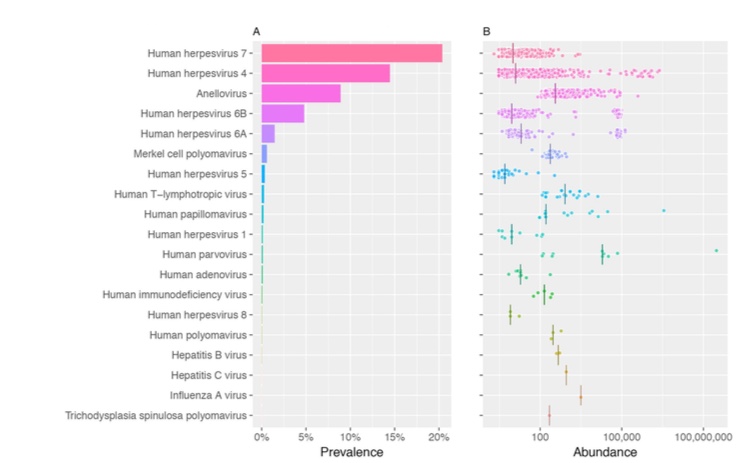In a massive sequencing analysis of viral DNA from over 8,000 individuals, a group of investigators led by and Human Longevity, Inc. and the Craig Venter Institute, both of California, determined that the three roseoloviruses are three of the five most common viruses detectable in blood.
HHV-7 – by far the most prevalent circulating virus – was identified in 20% of all individuals, while HHV-6B was present in 5% and HHV-6A was present in 1.5%. With the notable exceptions of EBV (14%) and Anellovirus (9%), all remaining viruses were identified in less than 1% of the study population. Most viruses don’t circulate in the blood extensively after the initial infection, and most of the 94 viruses found were barely detectable.

Prevalence and abundance of human DNA viruses and retroviruses in 8,240 individuals, ranked according to prevalence. Source: PLoS Pathogens, March 2017
Of interest, 50-55% of the HHV-6B and CMV positive individuals were age 20 or below. For HHV-7, the DNA was detected most commonly in individuals under 40 years old. The highest prevalence for HHV-6A, on the other hand, was among 40-60 year olds. Although HHV-6B was far more dominant in children under 20, HHV-6A had a relative proportion slightly higher than that of HHV-6B in individuals over 80.
The investigators were surprised to find an increased incidence of virus in men. Approximately 65% of HHV-6A positive individuals were male, compared to 55% for HHV-6B and 50% for EBV. The authors point out that one explanation for this phenomenon is that females may mount higher innate, cell mediated, and humoral immune responses than males (Robinson 2011).
HHV-6A was relatively more prevalent in the Middle East and Central South Asia, with no significant presence in East Asia. In contrast, EBV, HHV-6B, and HHV-7 were all found in East Asia. The prevalence of HHV-6A and HHV-6B in Africa was approximately the same, around 5%. HHV-7 was 3x more prevalent than HHV-6 in Africa and CMV DNA was not found in African samples.
The authors reported the prevalence of chromosomal integration in haploid sets to be approximately 0.5%, which translates to a 1% prevalence when both chromosome sets are included. Overall, the investigators found sequences to viruses in 42% of the study participants, including 19 human DNA viruses, proviruses, and RNA viruses, by examining non-human sequence data uncovered during whole-genome sequencing of 8,240 individuals and then matching sequences against thousands of sequences in national databases. They determined abundance of virus by estimating the number of viral genome copies per human diploid cell.
The Human Longevity Institute is a California venture started by Craig Venter and Peter Diamandis in 2013 with the goal of building a comprehensive database on human genotypes in an effort to use machine learning to develop new tools to detect and fight diseases associated with aging. The Craig Venter Institute is a non-profit genomics research institute that studies both genomics and the societal implications of genomics.
Read the full paper here: Mustafa 2017.

